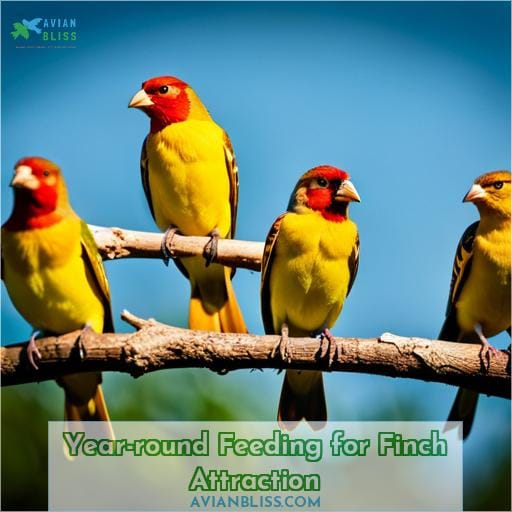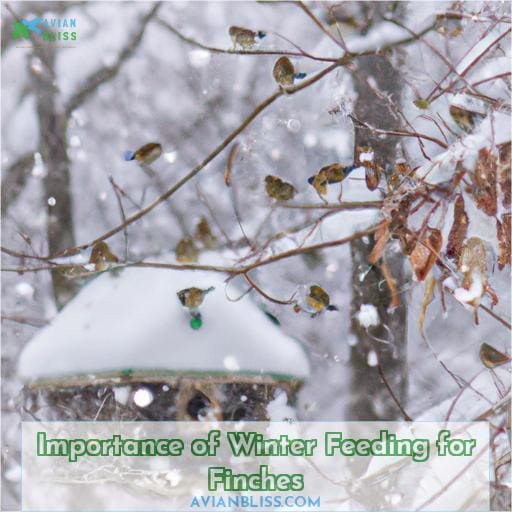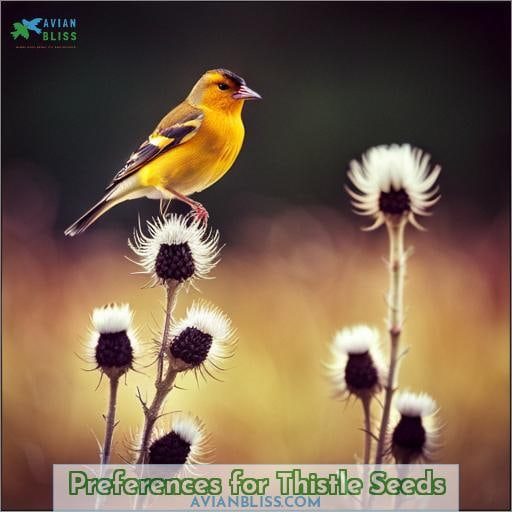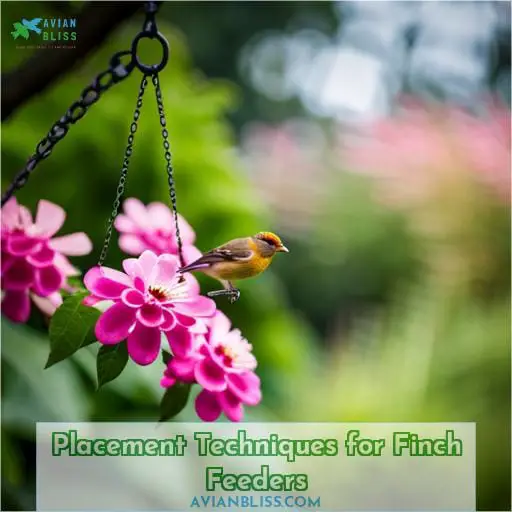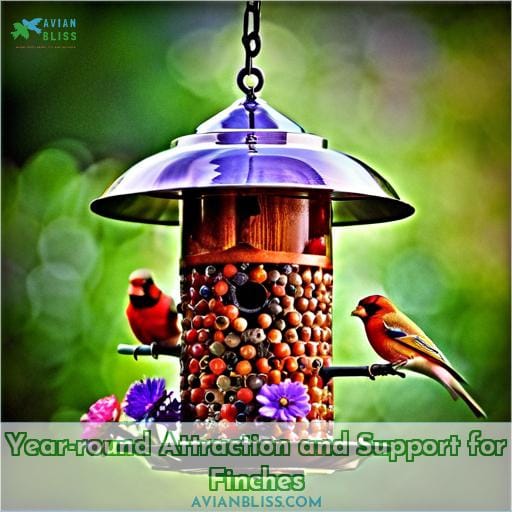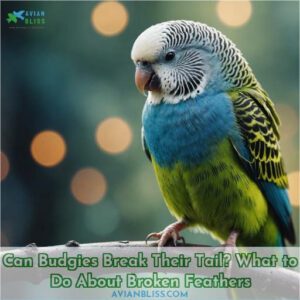This site is supported by our readers. We may earn a commission, at no cost to you, if you purchase through links.
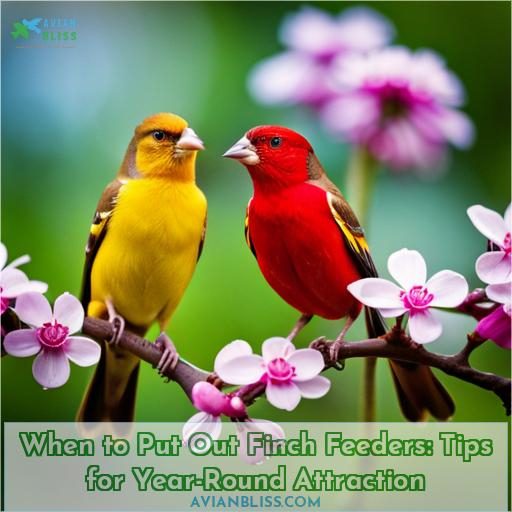 Watchin’ those colorful finches flutterin’ around your yard sure puts a smile on your face, don’t it? As an intuitive bird-lover, you get that satisfying feelin’ from providin’ the best care for your feathered friends.
Watchin’ those colorful finches flutterin’ around your yard sure puts a smile on your face, don’t it? As an intuitive bird-lover, you get that satisfying feelin’ from providin’ the best care for your feathered friends.
The good news is attractin’ finches year-round is easier than you think with the strategic placement of thistle feeders. Come spring, those bold goldfinches in their breedin’ plumage will flock to fresh thistle seed.
Durin’ the winter months, a steady supply of high-quality thistle mix along with shelter will keep those energetic birds fueled.
Follow some placement tips like usin’ natural habitat elements, and you’ll have happy finches comin’ back day after day. With the right knowledge, you can create a finch-friendly backyard that meets their needs while captivatin’ you with their beauty.
So grab some thistle seed and let’s get started makin’ your yard the neighborhood finches’ favorite hangout!
Table Of Contents
- Key Takeaways
- Year-round Feeding for Finch Attraction
- Importance of Winter Feeding for Finches
- Placing Feeders in Spring for Increased Attraction
- Types of Finch Feeders
- Advantages of Sock Feeders for Finches
- Considerations for Tube Feeders
- Preferences for Thistle Seeds
- Placement Techniques for Finch Feeders
- Year-round Attraction and Support for Finches
- Practical Tips for Finch Feeding
- Frequently Asked Questions (FAQs)
- Do finches feed on thistle seeds exclusively, or do they consume other types of seeds as well?**
- Are there any specific types of vegetation or plants that can be planted to attract finches to the feeder area?**
- How can I prevent unwanted bird species from being attracted to the finch feeders and consuming the seeds?**
- Are there any specific visual cues or designs, besides bright ribbons, that can help enhance the visibility of the finch feeders to attract the birds?**
- What are some key differences between the feeding patterns and preferences of migratory finches versus resident finches, and how should I adjust my feeder strategy accordingly?**
- Conclusion
Key Takeaways
- Spring is the best time to put out finch feeders, as goldfinches love thistle seed during this season.
- Proper feeder placement is essential for attracting finches, so consider timing and species when placing feeders.
- Regular cleaning and refilling of feeders are key to maintaining attraction.
- Winter feeding is crucial for migratory finches, so it is important to put out feeders during this season.
Year-round Feeding for Finch Attraction
You can attract finches year-round by maintaining clean feeders filled with their preferred seeds. Understanding finches’ seasonal feeding habits and migration patterns allows you to plan appropriate seed types, always keeping favorite thistle on hand.
Provide a fresh water source to aid attraction. In winter, migratory finches will visit feeders more as natural food grows scarce. Move feeders to new locations periodically to pique curiosity. Observe feeding behaviors to select compatible feeders and ideal placement near foliage cover.
Through attentive year-round care, your yard can become a safe, welcoming habitat for fascinating wild finches.
Importance of Winter Feeding for Finches
Let’s continue our conversation about optimal finch feeder timing by discussing the importance of winter feeding.
When natural food sources dwindle in the cold months, finches rely on alternative foods like feeders for winter survival. Without consistent energy sources like nutrient-rich thistle seeds from feeders, finches face dangerous outcomes of scarcity like energy deprivation.
Supplementing their diets with quality seeds from feeders helps finches endure the winter months when migration habits take many species away. Understanding finches’ increased dependence on feeders for sustenance in the winter underscores the importance of proper winter feeding and seed types for finches.
Thoughtful winter finch feeding habits support these remarkable birds through harsh seasons when natural sources cannot satisfy their needs.
Placing Feeders in Spring for Increased Attraction
Hang those colorful feeders in flowering trees now to draw lively finches to your yard this warming spring! The first signs of spring make it prime time to attract charming little finches. Carefully hang bright feeders near blooming flowers and fresh buds to entice them to stop at your oasis.
Schedule regular feedings as finches rely on your seeds during nesting season. Understand when migrating species pass through your area and expect peaked activity. Scout for sheltering trees and vertical posts that finches prefer when choosing feeder sites.
Embrace this fleeting chance to enjoy their beauty before nesting occupies them. With the right timing, you can immerse yourself in the magic of backyard birding and gain precious insight into their world by providing sustenance when they need it most.
Types of Finch Feeders
When attracting finches, the type of feeder you use can impact their comfort and access to food. Finch stations provide multiple feeding ports on a central platform, while feeder tubes offer slimmer cylindrical perches.
Sock feeders are an excellent option as they can be easily hung and allow finches to cling and extract thistle seeds.
Finch Stations
You’ll find finch stations make an excellent choice when it’s time to put out feeders.
- Store thistle seeds in the freezer to maintain freshness.
- Place the feeder under shelter to prevent wet seed.
- Follow a consistent filling schedule for steady finch attraction.
- Position the feeder near a water source for finch hydration and comfort.
- Ensure safe perching access for all visiting finch species.
Finch stations conveniently allow offering the right seeds while keeping the feed dry and accessible, supporting healthy finches that become devoted visitors.
Feeder Tubes
You can try tube feeders for larger birds, but they may deter smaller finches. Finches prefer thistle and tiny seeds; large tube feeders allow bigger grains to spill. Without shields, tubes get messy fast. Clean daily and remove milo, which finches dislike.
Hang a bright thistle feeder nearby, with red ribbons waving. This attracts colorful birds safely.
Sock Feeders
While tube feeders are okay for larger birds, sock feeders are fantastically astounding for finches to easily extract their beloved thistle seeds from! Bright-hued socks hung high amongst trees exactly mimic where finches naturally feed.
Proper placement ensures small birds feel safe while easily accessing their preferred seeds. Understanding migration patterns helps determine the optimal seed selection and sock feeder setup timing for attracting specific finch species to your backyard bird feeding habitat.
Advantages of Sock Feeders for Finches
Among the variety of feeders available for attracting finches, sock feeders are an excellent option to consider. After learning about the different tube and tray feeder types, it’s worth focusing on the benefits of sock feeders.
Their simple design allows easy hanging in shaded locations with proper drainage. With multiple seed ports accessible from all directions, finches feel safe from predators as they forage. The porous fabric contains fresh thistle and sunflower seeds – favorites that will entice finches to return.
Replenishing sock feeders with clean, quality seeds ensures a constant food source. Ultimately, combining seed-bearing plants with properly maintained sock feeders creates an ideal habitat for finches to thrive.
Considerations for Tube Feeders
Tube feeders may deter finches, so consider alternative styles if attracting them’s your aim.
Finches prefer smaller seeds that easily pass through tube feeder ports. If using a tube feeder:
- Select smaller seed sizes that easily flow through the feeder funnel and ports.
- Ensure wider funnel openings and port sizes to allow easy seed access.
- Add perches better suited for lighter birds like finches rather than large perching spaces.
Attracting birds requires understanding their needs. Finches specifically prefer quick access to small seeds through tube feeder openings. Carefully consider tube feeder dimensions and seed compatibility when trying to attract those energetic, acrobatic birds to your yard.
Preferences for Thistle Seeds
When selecting seeds for your finch feeders, focus on high-oil thistle varieties. Finches prefer thistle seeds for the energy boost. You’ll want to choose a mix with thistle as the main ingredient based on the finches you hope to attract.
Avoid mixes with milo or other filler seeds that attract unwanted birds. Tailor the seed mix over time as you learn the preferences of visitors to your yard.
High-Oil Thistle Seeds
You’ll attract more goldfinches by filling your socks with fresh, high-energy nyjer. High-fat thistle seeds provide the nutrition finches need. Their adaptations allow them to extract tiny seeds while perching.
Finches get crucial energy from thistle, sustaining them through harsh winters when natural food is scarce. Placing socks near plants offering additional forage ensures healthy diets, supporting wild finch survival.
With knowledge of avian needs and feeding habits, you can create an enriched habitat through proper feeder placement. Thoughtful backyard birdwatching gives birds security while revealing their beauty.
Seed Mixes With Thistle Seeds
Include a variety of seeds like sunflower and millet in your mix along with the thistle seeds that finches crave.
- Sunflower seeds attract cardinals, chickadees, and grosbeaks.
- Safflower seeds deter squirrels yet appeal to finches.
- Avoid milo, which falls from finch feeders.
Seed mixes with thistle complement finches’ appetites. Rotate fresh blends to satisfy diverse species.
Choosing Seeds Based on Finch Preferences
Your flock will be delighted when delicious, oil-rich treats await their eager beaks. Goldfinches will nibble lower on the thistle tube as American Goldfinches prefer smaller, softer seeds. Monitor milo in the mix as it can clog feeder ports. Offering multiple seeds allows finches to forage as they please, though ensure freshness by freezing surplus.
With a thoughtful backyard habitat, your home can become an avian oasis for all bird enthusiasts.
Avoiding Unwanted Bird Species
When selecting seeds, be mindful that certain mixes may entice undesired birds to your yard.
- Avoid mixes with milo, as it draws starlings and blackbirds.
- Choose thistle-specific mixes without filler seeds.
- Monitor the seeds that get eaten and discarded.
- Tailor mixes over time to deter nuisance birds.
- Rotate feeder locations seasonally to favor target species.
Carefully choosing finch-preferred seeds deters pest birds while supporting desired species. Varying feeder sites also reduces squabbles and disease transmission amongst congregating birds.
Excluding Milo From Seed Mixes
You’d be wise to omit milo from seed mixes as finches largely disregard it. Instead, ensure that at least 70% of the blend is fresh black oil sunflower seeds, which provide the high-fat content finches need.
Milo easily falls from tube feeders, littering the ground and attracting unwanted birds like doves. Choose proper feeders to hold sunflower seeds yet deter squirrels and large birds from gorging. Timing and selection ensure good seeds for target finches rather than those drawn to waste below.
Placement Techniques for Finch Feeders
Let’s welcome feathered friends to your yard. Replicate their natural habitat by planting tall trees and dense shrubs, position feeders near sheltering branches for safety, and add a water source to aid attraction.
Dazzle finches with bright ribbons, allow for natural discovery, and plant flowers like daisies, cottonwood, and marigold to entice them.
Replicating Habitat With Trees and Shrubs
Dense shrubbery behind the stalks of fake trees huddles close, offering shelter and protection while drawing in finches.
- Mimic the natural tree bark texture and appearance.
- Choose robust, leafy plants that finches feel safe within.
- Advance the habitat by planting cottonwood, dogwood, and juniper.
- Copy the look of their wild homes through strategic placement.
- Make your involvement seem natural by letting finches discover the feeder.
By thoughtfully designing an environment finches recognize, you tap into their instincts to visit and return.
Shelter Proximity for Safety
You’ll wanna keep finch feeders around 10 feet away from shelters so the birds feel safe enough to visit while not being too exposed to predators. I know it’s tempting to place them right by windows for easy viewing, but a little distance makes all the difference in getting those finches to stick around.
| Shelter Type | Distance | Reasoning |
|---|---|---|
| Trees | 8-12 feet | Allows quick escape to branches |
| Shrubs | 6-10 feet | Gives cover while feeding |
| Buildings | 10+ feet | Prevents window collisions |
Feeders kept too close to shelter risk startling finches and deterring their return. But a comfortable distance accommodates their caution while ensuring your generous offerings remain irresistible.
Thoughtful placement shows you care for their wellbeing.
Attracting Finch With Water Source
Didn’t know water nearby draws finches towards feeders. A solar-powered bath with a dripping water feature placed 10 feet from the feeder provides constant attraction. The sound and movement of shallow, clean water entices curious finches longing for an oasis.
Satisfy their innate thirst at your yard sanctuary. Offer what scarce nature cannot. Be the dependable lifeline amidst arid uncertainty. Quench more than their endless wanderings. Hydrate thriving health beyond transient sustenance. For flowing water nurtures far greater needs than seeds alone ever could.
Planting Flowers for Attraction
You can attract finches by planting daisies, cottonwood, poppies, and marigolds near the feeders for their comfort. House finches favor urban areas with vertical structures and abundant vegetation. Strategically landscaping your yard with preferred flowers and shrubs encourages visiting and nesting.
A birdbath placed 10-15 feet from feeders and surrounded by plants provides an optimal environment. Select vibrant flowers like daisies and cottonwood for year-round color and nectar.
Allowing Natural Discovery of Feeders
Let nature guide the finches to their sustenance. Set up wind chimes and mobiles nearby, allowing gradual exposure. Include a birdbath for bathing and drinking. Let the finches find the feeders on their own terms, drawn in by the restful chimes, swirling mobiles, and promise of fresh water.
Using Bright Ribbons for Visibility
Hang colorful ribbons near your finch habitat to attract their attention.
- Experiment with bright yellow, red, blue, and purple ribbons.
- Vibrant colors stand out against the backdrop of your yard’s trees and shrubs.
- Place ribbons at different heights and locations near your feeder for maximum visibility.
- Change ribbon placement if finches don’t initially notice them.
Ribbons draw finches’ attention to your carefully placed feeder, enhancing its setup timing for attracting the naturally curious birds.
Year-round Attraction and Support for Finches
Birds need our help, especially finches, during the lean winter months. Providing clean, fresh seed in feeders year-round will support their population, and regular cleaning and seed replacement keeps your feeders inviting.
Supporting Finch Population in Winter
Attracting finches in winter aids their population. Winter’s dead grass and rain leave few shelter options, so placing feeders near trees or shrubs offers crucial gathering spaces. Finches flock together, finding safety in numbers against predators. Leftover nesting material meets their perching needs.
Thoughtfully placed feeders provide sustenance when natural food sources dwindle, supporting survival through harsh months.
Maintaining Feeder Freshness
You’ve got to regularly clean and replace those seeds, or else you’ll be attracting a lot more than just finches. Keeping feeders clean and seeds fresh ensures healthy finches seek your feeders. Select high-quality thistle seeds, store them properly, and routinely replace dried seeds.
Schedule weekly feeder cleanings with soap and water. Assess seed quality by feel and appearance. Choose squirrel deterrents that allow full finch access. With diligent feeder maintenance, your yard becomes a thriving finch habitat.
Practical Tips for Finch Feeding
You can optimize your finch feeding success by techniques such as temporary feeder removal, half-filling new feeders, using fresh black thistle seeds, refilling feeders often, adding weather guards, proper placement for refilling access, considering timing and location based on species and migration, and using color, movement, and mimicking other finches to attract them.
Proper feeder setup and maintenance, combined with an understanding of finch behavior and needs, will lead to healthy, consistent attraction of these lively birds to your yard.
Temporary Feeder Removal
Yank those old feeders temporarily to excite fresh finch interest in the new one you just hung. Finches instinctively inspect new food sources while avoiding areas with invasive predators or traffic noise.
Carefully observe migration tracking and plant vegetables that attract breeding birds. Account for weather considerations, as finches rely on feeders most during winter scarcity.
Half-filling New Feeders
To lure finches, fill your new feeder halfway so it appears secure. Tutoring visitors with ribbons, flowers, and a half-full feeder simulate company, signaling the space is safe to befriend finches. Providing fresh seeds, a water source, and planted daisies fosters an engaging habitat.
Using Fresh Thistle Seed
Promote finch attraction by replenishing empty feeders with recently purchased thistle seeds. Experience color attraction once thistle feeders are half-empty, and finches will return to the fresh nourishment you provide.
Store extra seeds in your freezer for optimal thistle freshness, replacing stale seed regularly for smooth seed dispensing. With this weather guard in place, your yard will flourish with the joy of feasting finches.
Regular Refilling of Feeders
You’re giving finches a hand when you keep their feeders freshly filled.
- Check feeders often for low seed levels.
- Refill half-empty feeders to ensure ample food.
- Top off feeders at the end of each day.
- Adjust refill frequency by season – more in winter.
- Offer a variety of seeds suited to the season.
Regular feeder refills show finches that your yard is a reliable food source.
Weather Guard for Wet Seeds
Place a roof over your feeder to prevent rain from soaking the seeds. A splash shield above the feeder openings or a resealable seed container like a garbage can will guard against wet seeds. Store extra seed in the freezer to maintain freshness. Consider a waterproof covering for the entire feeder to fully protect your nutritious seed mix from the elements.
With a little forethought, you can keep your finches well-fed even during rainy weather.
Proper Placement of Feeders for Refilling
Keep your feeders handy for refilling yet out of reach of windows for the finches’ safety. Mount your feeder on a stable branch near a tree but far from the house, just within reachable height for you.
Hang it under the eaves if you can. That spot keeps the food dry while letting you easily tend to the feeding needs of your feathered friends.
Timing and Location Considerations
Partner, the timing to attract your feathery friends varies like the seasons, so consider the habits of the species you wish to draw in before setting out their feast. To optimize timing for specific species, monitor migration patterns and minimize feeder competition by providing diverse food sources.
Year-round feeding is often necessary, but tailoring feeder placement to migration habits will maximize attraction.
Attraction Techniques for Finches
Enhance your garden with vibrant attractants like colorful ribbons and lifelike movements to captivate the charming finches’ attention and enliven your outdoor space. Use attractive foliage to create a natural oasis, enticing finches with both shelter and sustenance.
Camouflage feeders within lush vegetation to offer a sense of security, drawing these delicate birds closer. Employ visual scare tactics sparingly to deter potential threats while maintaining a haven of tranquility.
Consider installing seasonal nest boxes to foster a sense of belonging, and explore sound attraction techniques, like gentle chimes, to add a melodic touch to their paradise.
Frequently Asked Questions (FAQs)
Do finches feed on thistle seeds exclusively, or do they consume other types of seeds as well?**
Finches are partial to thistle seeds due to their high oil content, providing essential energy. However, they also accept seed mixes with other small seeds, catering to their preferences and nutritional needs.
Are there any specific types of vegetation or plants that can be planted to attract finches to the feeder area?**
To attract finches, cultivate Black-Eyed Susans, poppies, and marigolds. Employ ribbons for vibrant allure. Mimic companionship by half-filling feeders, signaling safety. Create a haven that beckons with color, movement, and nourishment.
How can I prevent unwanted bird species from being attracted to the finch feeders and consuming the seeds?**
To prevent unwanted bird species from consuming the seeds of your finch feeders, choose thistle-based mixes that are preferred by finches. Opt for feeders that discourage larger birds and place them away from shelters. Use colorful ribbons to attract finches, and keep their interest by providing fresh, specific seeds.
Are there any specific visual cues or designs, besides bright ribbons, that can help enhance the visibility of the finch feeders to attract the birds?**
Enhance finch feeder visibility with natural cues, such as mimicking bird activity through swaying branches and incorporating reflective materials. Additionally, use a variety of vibrant colors to captivate the attention of finches, fostering a sense of security and freedom.
What are some key differences between the feeding patterns and preferences of migratory finches versus resident finches, and how should I adjust my feeder strategy accordingly?**
To attract migratory finches, provide feeders during their winter journeys and cater to their high-energy needs. Resident finches favor year-round feeders; adjust offerings to their seasonal preferences for optimal enjoyment.
Conclusion
As the sun’s journey through the seasons orchestrates nature’s ever-changing symphony, so does your role in nurturing the delicate harmony of finch attraction. The key to coaxing these vibrant creatures to your haven lies not only in the science of timing but also in the art of understanding their instincts.
Throughout the year, these feathered voyagers remain faithful inhabitants, and your offering of sustenance can be a year-round serenade.
Embrace the colder months as a vital chapter in this avian tale. When winter’s icy breath sweeps across the land, your provision becomes a lifeline, a beacon of warmth amidst the frosty landscapes. Placing feeders during these stark months, their barren branches accentuated by the vibrancy of your offerings, is a gesture of compassion etched in the tapestry of survival.
As spring’s tender touch awakens nature’s canvas, seize the opportunity to compose a symphony of colors and life. The burgeoning plants and warming sun beckon finches to dance in your garden. Positioning feeders amidst this awakening world is akin to setting a banquet table for newfound friends, inviting them to revel in the abundance of your thoughtful gesture.
The array of feeder types presents you with an artistic palette. Finch stations, feeder tubes, and the whimsical socks each cater to the unique preferences of these delicate visitors. A sock, effortlessly hanging, lures them in with promises of thistle seeds to savor.
Yet, consider the balance; while tube feeders may play host to larger birds, finches might pause before partaking in their feast.
Ah, the thistle seed – a golden nugget of sustenance coveted by finches. The high-oil thistle seeds are their nectar of energy, the elixir that fuels their flight. When selecting seed mixes, remember the melody of their visits, and harmonize their preferences with your offerings.
In the theater of placement, become the director of finch allure. Tall trees and verdant shrubs become the backdrop, beckoning these feathered actors to your stage. Maintain a watchful distance, granting them security while they feast. A nearby water source becomes a refreshing oasis, an encore to their feast.
In your garden’s embrace, finches find not only sustenance but sanctuary. Every ribbon fluttering in the breeze is a whisper of invitation, and every half-filled feeder is a promise of safety. So, time your overture carefully, from the cold grasp of winter to the promise of spring’s awakening.
For when you put out finch feeders, you compose a melody that echoes through the seasons, a testament to your harmony with the avian world.

